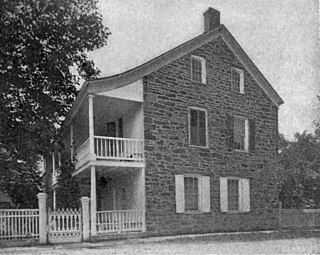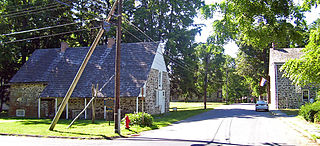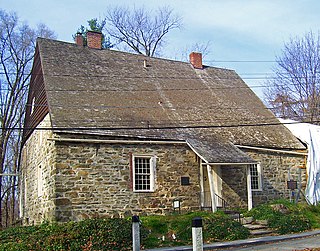
Abraham Bruyn Hasbrouck was a United States Congressman from New York and the sixth President of Rutgers College serving from 1840 to 1850. He was a slaveholder.

Louis Du Bois was a Huguenot colonist in New Netherland who, with two of his sons and nine other refugees, founded the town of New Paltz, New York. These Protestant refugees fled Catholic persecution in France, emigrating to the Rhenish Palatinate and then to New Netherland, where they settled in Wiltwyck and Nieuw Dorp (present-day Hurley, New York, settlements midway between New Amsterdam and Beverwyck before ultimately founding New Paltz.
Hasbrouck House may refer to:

Josiah Hasbrouck was a United States representative from New York. Born in New Paltz, he completed preparatory studies and conducted a general merchandising business. He was a second lieutenant in the Third Regiment of Ulster County Militia in 1780, and was supervisor of New Paltz from 1784 to 1786 and in 1793, 1794, and 1799 to 1805. He was a member of the New York State Assembly in 1796, 1797, 1802, and 1806.

Historic Huguenot Street is located in New Paltz, New York, approximately 90 miles (140 km) north of New York City. The seven stone houses and several accompanying structures in the 10-acre National Landmark Historic District were likely built in the early 18th century by Huguenot settlers fleeing discrimination and religious persecution in France and what's now southern Belgium. After negotiating with the Esopus Indians, this small group of Huguenots settled on a flat rise on the banks of the Wallkill River in 1678. The settlers named the site in honor of Die Pfalz, the region of present-day Germany that had provided them temporary refuge before they came to America. Archaeological finds indicate that the immediate area settled by the Huguenots was occupied by Native Americans prior to European contact. The site is one of the oldest continuously inhabited settlements in the United States.

Abraham Joseph Hasbrouck was a United States representative from New York and a slaveholder.

The Jean Hasbrouck House is a historic house on Historic Huguenot Street in New Paltz, New York. Built in 1721, it is one of the best examples of colonial Dutch architecture in stone in the United States. The house is a National Historic Landmark and is part of the larger Huguenot Street Historic District, also a National Historic Landmark.

The Wallkill Valley Rail Trail is a 22.5-mile (36.2 km) rail trail and linear park that runs along the former Wallkill Valley Railroad rail corridor in Ulster County, New York. It stretches from Gardiner through New Paltz, Rosendale and Ulster to the Kingston city line, just south of a demolished, concrete Conrail railroad bridge that was located on a team-track siding several blocks south of the also-demolished Kingston New York Central Railroad passenger station. The trail is separated from the Walden–Wallkill Rail Trail by two state prisons in Shawangunk, though there have been plans to bypass these facilities and to connect the Wallkill Valley Rail Trail with other regional rail-trails. The northern section of the trail forms part of the Empire State Trail.

The Jenkins–DuBois Farm and Mill Site is located along Jenkinstown Road in Gardiner, Ulster County, New York, United States. It was started by settler Lambert Jenkins in 1793 with a stone house and mills on land part of the original Huguenot Patent owned by Louis DuBois of nearby New Paltz. The Jenkins–DuBois descendants still live on the land today.

The Shuart-Van Orden Stone House is located on Allhusen Road in Plattekill, New York, United States, near the Thaddeus Hait Farm. The original stone house was built in 1740. It was added to the National Register of Historic Places in 1995, as a highly stylized version of a typical Hudson Valley Dutch Colonial house, the use of brick and gambrel roof in its construction reflecting the influence of migrants from New Jersey and New York City, where that was more common.

William Cornelius Hasbrouck was an American lawyer and politician.

The Bevier House Museum, referred to simply as the Bevier House or Bevier Stone House prior to its conversion from a private residence, is located in Marbletown, near Kingston, New York. The house is also the home of the Ulster County Historical Society and is currently open to the public as a museum.

The Locusts, also known as the Peter Eltinge House, is a 19th-century brick Federal style house built in 1826 located on Plains Road in the Town of New Paltz, New York, United States, two miles (3 km) south of the village of New Paltz. It was once the center of a large farm. The house and several outbuildings have been listed on the National Register of Historic Places as well-preserved examples of that style in Ulster County.

The Major Jacob Hasbrouck Jr. House is located on Huguenot Street in the Town of New Paltz, New York, United States. It was built in 1786 by Hasbrouck, grandson of Jean Hasbrouck, one of the original Huguenot settlers of the New Paltz area in the late 17th century, after he had moved out of the family home, two miles (3.2 km) to the south in what is today the Huguenot Street Historic District. A descendant of his lives in the house today, and it is believed to be the only 18th-century stone house in the New Paltz area continuously owned by the family that first built it.

Gardiner is a town in the south-central part of Ulster County, New York, United States. The population was 5,713 at the 2010 census.

New Paltz is a village in Ulster County located in the U.S. state of New York. It is approximately 80 miles (130 km) north of New York City and 70 miles (110 km) south of Albany. The population was 7,324 at the 2020 census.

The Station is an Italian restaurant and former train station in the village of New Paltz in Ulster County, New York. The building was the first of two railroad stations constructed in the town of New Paltz, and it is the only former Wallkill Valley Railroad station standing at its original location.
Louis Hasbrouck was an American lawyer and politician from New York.
Abraham A. Deyo was an American politician from New York.
The Hasbrouck family was an early immigrant family to Ulster County, New York, and helped found New Paltz, New York. The Hasbrouck family were French Huguenots who fled persecution in France by moving to Germany, and then the United States. Two brothers, Jean II and Abraham, are the ancestors of almost all individuals in the United States with the last name "Hasbrouck," or some variation.






















